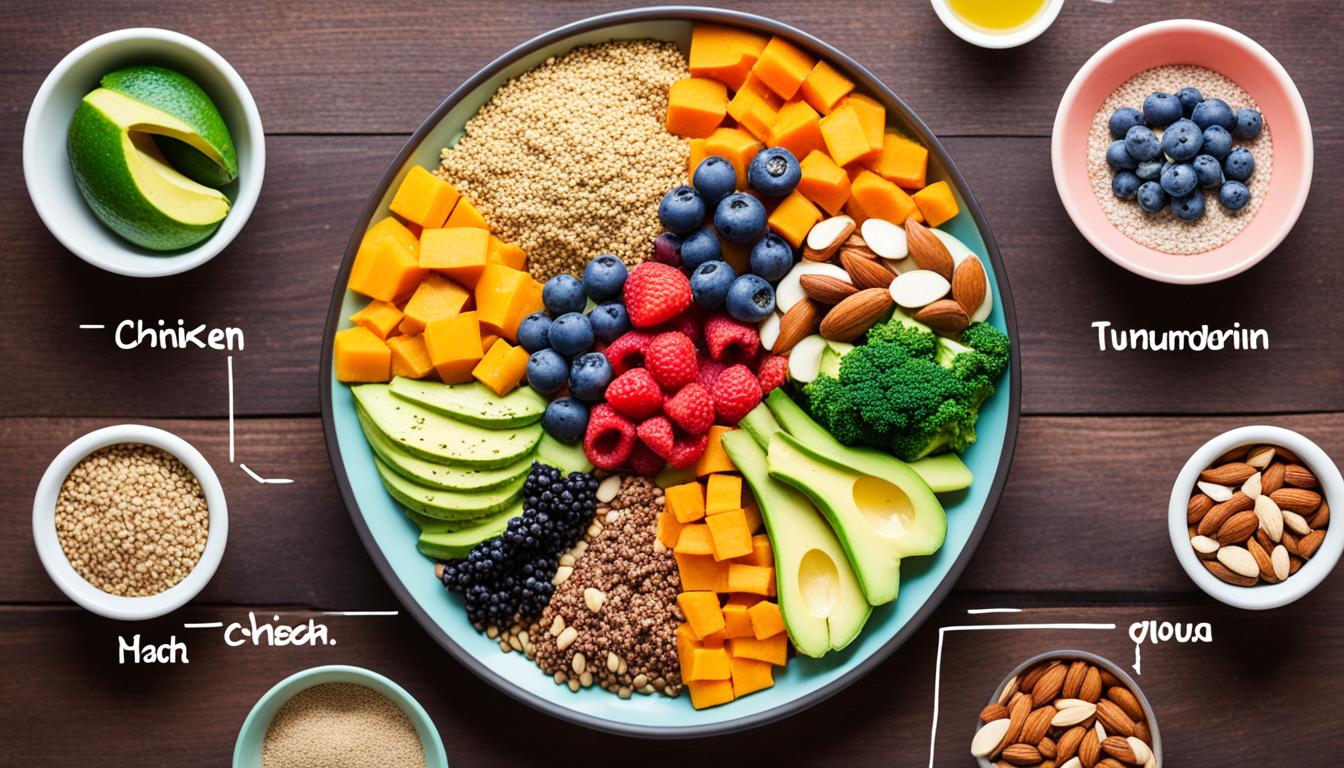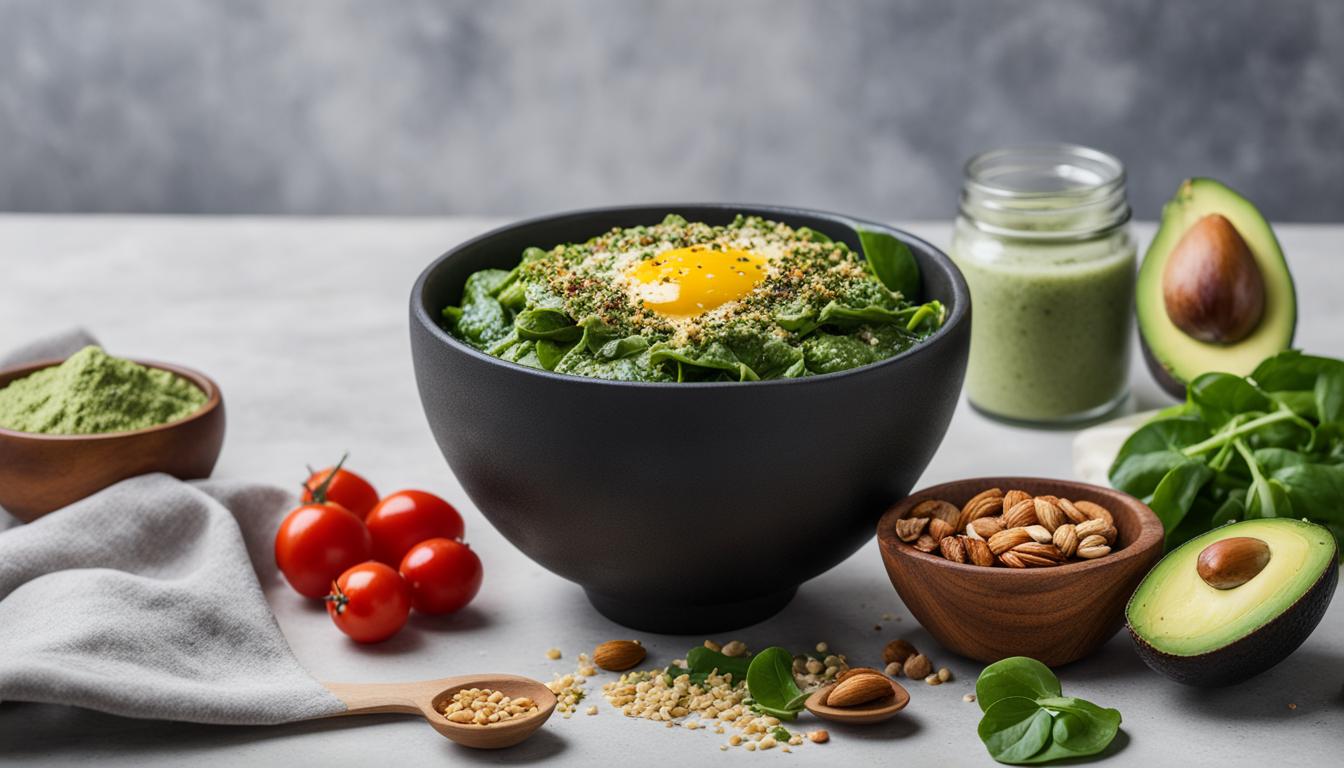Whether you’re new to fitness or a seasoned pro, making a macro meal plan can be a game-changer in helping you reach your goals. A macro meal plan is a meal plan that’s based on the macronutrients your body needs – protein, carbohydrates, and fat. It’s a flexible and effective way to ensure you’re getting the nutrients your body needs while still enjoying delicious meals.
In this section, we will cover the basics of creating a macro meal plan and provide you with a macro meal planning guide to support you through the process.
Key Takeaways:
- A macro meal plan is based on the macronutrients your body needs, including protein, carbohydrates, and fat.
- To create an effective macro meal plan, start by understanding macro nutrients and how they impact your body.
- Set your goals and determine your caloric intake before calculating your macro ratios.
- Proper meal planning and preparation can help you stick to your macro meal plan and stay on track with your goals.
- Keep your meal plan enjoyable and sustainable by incorporating variety and flexibility.
Understanding Macro Nutrients
Before diving into creating a macro meal plan, it’s important to understand the concept of macro nutrients. These are the nutrients that our bodies require in large quantities to function optimally. The three main macro nutrients are:
| Macronutrient | Calories Per Gram | Functions | Food Sources |
|---|---|---|---|
| Carbohydrates | 4 calories | Primary energy source, brain fuel, blood sugar regulation | Whole grains, fruits, vegetables, legumes |
| Proteins | 4 calories | Building and repairing tissues, enzymes, hormones | Chicken, fish, meats, eggs, dairy, legumes, nuts |
| Fats | 9 calories | Energy storage, insulation, absorption of vitamins | Nuts, seeds, avocado, oils, butter, fatty fish |
By counting and balancing these macros, we can create a meal plan that supports our specific goals. Macro counting for meal planning is a method of tracking the amount of each macro nutrient consumed throughout the day to ensure that you are meeting your daily requirements.
Why Understanding Macros is Important
Understanding macros is important because it allows us to tailor our diet to meet our specific goals. For example, someone looking to lose weight may focus on reducing their carbohydrate intake, while someone looking to build muscle may focus on increasing their protein intake. Macro counting also allows us to ensure that we are fueling our bodies with the necessary nutrients, which can improve overall health and wellbeing.
“By counting and balancing these macros, we can create a meal plan that supports our specific goals.”
Setting Your Goals and Caloric Intake
To create a successful macro meal plan, it’s important to start with clear goals and a target caloric intake. This requires a bit of research and planning to calculate the optimal number of calories you need to consume for your specific body type and fitness goals. Fortunately, there are several macro meal plan calculators available online that can assist you in this process.
For example, FitnessVolt offers a straightforward macro calculator that takes into account your age, height, weight, and activity level to determine your basal metabolic rate (BMR). This is essentially the number of calories your body requires at rest. From there, the calculator can help you determine your total daily energy expenditure (TDEE), which provides an estimate of the number of calories necessary to maintain your current weight.

However, keep in mind that the calculators are only a starting point and may not be accurate for everyone. It’s important to listen to your body and adjust your caloric intake based on how you feel. If you’re not seeing the desired results after a few weeks, you may need to adjust your calorie intake or macro ratios accordingly.
Calculating Your Macro Ratios
Creating a meal plan based on macros requires calculating the percentage of each macro nutrient to consume every day. The ratio primarily depends on your fitness goals, current body composition, and activity level. For instance, if your aim is to lose weight, a common ratio is 40% carbohydrates, 30% protein, and 30% fat.
It’s essential to note that macro ratios aren’t set in stone and can be adjusted based on personal preferences and progress. Here is a breakdown of the macro nutrients and their role in your body:
| Macro Nutrient | Calories per Gram | Role in the Body | Foods High in Nutrient |
|---|---|---|---|
| Carbohydrates | 4 | Provide energy for the body and brain | Brown rice, quinoa, sweet potato |
| Protein | 4 | Build and repair tissues, regulate hormones and enzymes | Chicken breast, salmon, tofu |
| Fat | 9 | Protect organs, maintain body temperature, absorb essential vitamins | Avocado, nuts, olive oil |
Incorporating a variety of foods from each macro category can ensure balanced nutrition and make meal planning exciting.
Plan Your Meals
Now that you know your macro ratios, it’s time to create a meal plan that suits your nutritional needs. Here are some tips on how to plan macro meals:
- Make a food list: Start by creating a list of foods that fit into each macro category, such as whole grains, lean protein, and healthy fats. You can find macro-friendly recipes and food ideas online to get you started.
- Combine the macros: Once you have your food list, combine them to form balanced meals that hit your macro ratios. Use a food scale or measuring cups to ensure accurate portion sizes.
- Consider variety: Incorporate a variety of foods into your meal plan to avoid boredom and ensure that you’re getting all the necessary nutrients. Try new recipes and experiment with different food combinations.
Here’s an example of what a typical day of macro meals might look like:
| Meal | Macro Ratio | Example |
|---|---|---|
| Breakfast | 40% carbs, 30% protein, 30% fat | Egg scramble with spinach, mushrooms, and avocado |
| Snack | 40% carbs, 30% protein, 30% fat | Apple slices with almond butter |
| Lunch | 40% carbs, 30% protein, 30% fat | Grilled chicken breast with quinoa and roasted vegetables |
| Snack | 40% carbs, 30% protein, 30% fat | Cottage cheese with berries and almonds |
| Dinner | 40% carbs, 30% protein, 30% fat | Salmon with sweet potato and green beans |
| Snack | 40% carbs, 30% protein, 30% fat | Greek yogurt with granola and honey |
Remember, your meal plan should be tailored to your goals and lifestyle. With these tips and an understanding of macro nutrients, you can create a sustainable and effective macro meal plan.

Meal Prep and Batch Cooking
Meal prepping and batch cooking can make a macro meal plan much easier to maintain. By taking the time to prepare and cook meals in advance, you can save time throughout the week and have healthy meals ready to go whenever you need them.
Here are some tips to help you with meal prep for your macro diet:
- Set aside time each week for meal prep and batch cooking.
- Plan out your meals for the week in advance.
- Cook in bulk to save time and effort.
- Invest in good quality tupperware containers to store your prepped meals.
- Label your meals with the date they were prepared and the macro ratios.
Not only does meal prepping save time, but it also helps you stay on track with your macro meal plan. When you have healthy meals ready to go, you’re less likely to reach for unhealthy options when you’re short on time or feeling hungry.
Adjust and Monitor Your Progress
While a macro meal plan can be highly effective for weight loss and improving overall health, it’s important to remember that no two bodies are the same. As you follow your meal plan, be sure to monitor your progress and listen to your body. If you feel tired, unmotivated, or unwell, it may be time to make some adjustments to your plan.
Tracking your food intake and progress can also help you stay motivated and maintain accountability. Consider using a food tracking app or writing down your meals in a journal. This can provide valuable insights into what’s working and what’s not, helping you make more informed decisions about your diet.
When adjusting your plan, be sure to do so gradually to avoid shock to your system. Remember, the key to success with a macro meal plan is finding a sustainable approach that works for you.
One of the primary benefits of macro meal planning is its versatility and flexibility. While macro ratios and calorie counts provide structure and guidance, there’s still plenty of room for creativity and variety in your meals.
By incorporating a diverse range of nutrient-dense foods, you’ll not only meet your macronutrient needs but also ensure you’re getting all the necessary vitamins and minerals for optimal health. Experiment with new recipes and food combinations to keep things interesting and enjoyable.
Overall, a well-planned and personalized macro meal plan can be an excellent tool for weight loss and overall health. By monitoring your progress, making adjustments when necessary, and incorporating variety and flexibility, you can achieve your goals and maintain a sustainable approach to healthy eating.
Incorporate Variety and Flexibility
Sticking to a macro meal plan can be a challenge, but incorporating variety and flexibility into your diet can make it more enjoyable and sustainable. While it’s important to stay on track with your macro ratios, don’t be afraid to try new things and experiment with different food combinations.
Here are some macro meal plan ideas to get you started:
- Swap regular pasta for zucchini noodles or spaghetti squash to lower your carb count.
- Try making your own protein bars or energy bites using whey protein powder and healthy ingredients like nuts, seeds, and dark chocolate.
- Make a macro-friendly version of your favorite takeout dish by using lean protein sources and plenty of veggies.
- Use Greek yogurt or cottage cheese as a base for sauces and dips instead of high-fat options like sour cream or cream cheese.
- Experiment with different types of protein sources, like tempeh, seitan, or tofu, to add variety to your meals.
Remember, creating a meal plan with macros doesn’t have to be restrictive. Incorporating variety and flexibility can make it a sustainable and enjoyable approach to healthy eating.
Conclusion
In conclusion, creating a macro meal plan can greatly support your fitness goals and provide you with a structured approach to nutrition management. By understanding macro nutrients and incorporating them into your meal plan, you can effectively nourish your body and achieve desired results.
Remember to approach macro meal planning as a sustainable and enjoyable journey, prioritizing balance and flexibility. It’s essential to monitor your progress and make adjustments if necessary, while also incorporating variety and trying out new recipes. With the proper dedication and effort, a macro meal plan can be a highly effective tool in achieving your fitness goals.
FAQ
How do I build a macro meal plan?
To build a macro meal plan, start by understanding macro nutrients and their importance. Set your goals and calculate your caloric intake using online calculators. Determine your macro ratios based on your goals, plan your meals accordingly, and consider meal prepping and batch cooking. Adjust and monitor your progress, incorporate variety and flexibility into your diet, and stay motivated and accountable by tracking your food intake and progress.
What are macro nutrients and why are they important?
Macro nutrients are carbohydrates, proteins, and fats, which are all essential for our bodies. They provide energy, support muscle growth and repair, and help regulate bodily functions. Understanding and incorporating macro nutrients into your meal plan can help you achieve your fitness goals and maintain a healthy diet.
How do I set my goals and determine my caloric intake?
Setting your goals involves determining whether you want to lose weight, gain muscle, or maintain your current physique. To determine your caloric intake, you can use online calculators that take into account factors such as gender, age, weight, activity level, and goals. These calculators provide an estimate of the number of calories you should consume in a day.
How do I calculate my macro ratios?
Once you have your caloric intake, you can calculate your macro ratios. Common ratios for weight loss include 40% carbohydrates, 30% protein, and 30% fat. However, the ratios can vary depending on individual goals and preferences. Online calculators can also help you determine the ideal macro ratios for your specific goals.
How do I plan my macro meals?
Planning your macro meals involves creating a list of foods that fit into each macro category and then combining them to form balanced meals. Consider portion sizes and variety to ensure you’re getting all the necessary nutrients. You can also find meal planning guides and recipes online to help you get started.
How can meal prep and batch cooking help with my macro meal plan?
Meal prepping and batch cooking can save you time and make sticking to your macro meal plan easier. Set aside time each week to prepare and cook meals in advance, so they’re ready to grab and eat throughout the week. This ensures that you have convenient and healthy options available, which can prevent you from making impulsive food choices.
How do I adjust and monitor my progress on a macro meal plan?
As you follow your macro meal plan, it’s important to monitor your progress and make adjustments if necessary. Everyone’s body is different, so pay attention to how you feel and make changes accordingly. Tracking your food intake and progress using apps or journals can help you stay motivated and accountable.
Can I have variety and flexibility in a macro meal plan?
Absolutely! While sticking to a macro meal plan is important, it’s also crucial to incorporate variety and flexibility into your diet. Try new recipes, experiment with different food combinations, and allow yourself occasional treats. By maintaining a balanced and enjoyable approach to healthy eating, you can sustain your macro meal plan in the long run.


